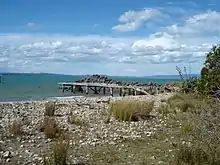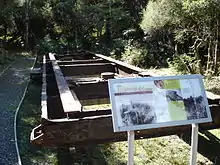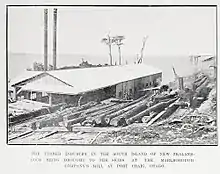Port Craig
Port Craig is located along the south coast (Te Waewae Bay) of the South Island New Zealand near Tuatapere. It was a small logging town born in 1916, with 200+ men women and children living there in its prime. Like other New Zealand bush towns, Port Craig was inhabited by hardy kiwi bushmen and their families, recent immigrants and a few others trying to keep clear of the law. The Marlborough Timber Company had a large scale plan to log one of the countries last significant coastal forests. The company planned big, they built the Dominion's largest sawmill, an extensive tramway system, port facilities and township all without road access. The bush was worked by the Lidgerwood overhead logging cable system (gantry) that weighed over 50 tonnes. The immense size of the gantry meant that it was very difficult to relocate in the inhospitable forest and after one major shift, the gantry was left redundant, crippling the local logging industry.


All that is left of the town is considerable relics including the gantry base, a large English built wince (built in Hull) that operated on the wharf and thousands of bricks. There is also a fairly complete bakers oven and the original school building that is now used as a trampers hut.
History
Whaling
Mussel Beach had the remains of a whaling station and a 6-oared whaling boat in 1877.[1]
Tracks
The track from Bluecliffs via Mussel Beach to Puysegur was improved when a phone line was erected in 1908,[2] the first base camp being at Mussel Beach.[3] Cages were installed to cross the major rivers.[4] It was further improved in 1919 and 1920 to a horse track from Bluecliffs to Port Craig.[5][6][7]
Logging

The logging days commenced in 1917 and continued till about 1929, when it shut down in the face of the looming depression.
Tramway
Work started on the 3 ft 6 in (NZR gauge) Port Craig tramway in 1917. It ran south from Port Craig, parallel to the coast, for 14.6 km (9.1 mi) to Wairaurahiri River,[8] with a further 9.8 km (6.1 mi) of branches.[9] It extended over a mile from the mill by 1921[10] and was extended in 1924.[11] The line was worked by steam locomotives from 1919,[12] including the largest bush locomotive built by A & G Price, a Meyer type Ar 0-4-4-0T,[13] which was on the line from 1926 to 1931.[14] The rails were removed in 1939.[15]
Nature
The area is remote from any big towns or districts, and this led Port Craig to keep surrounding natural environment at its beauty. Southern right whales and Hector's dolphins sometimes can be seen cavorting close to shores. As early as 1896 it was observed that ferrets seemed to have exterminated wekas and kakapo as far west as the Waitutu River.[16]
Walking Tracks
Parts of the tramway were cleared in 2009 to form a route for the Hump Ridge and South Coast Tracks and the school became a hut.[17]
See also
- Hump Ridge Track
- Percy Burn Viaduct
- Tuatapere
- Waitutu Forest
References
- "Ooverland from Preservation Inlet.(Otago Daily Times, 1872-12-02)". paperspast.natlib.govt.nz. Retrieved 2018-06-24.
- "The Destruction of Native Birds (Southland Times, 1908-02-19)". paperspast.natlib.govt.nz. Retrieved 2018-06-24.
- "A LINEMAN'S LIFE ON THE PUYSEGUR TRACK. (Press, 1912-09-18)". paperspast.natlib.govt.nz. Retrieved 2018-06-24.
- "Local and General (Otago Witness, 1910-07-27)". paperspast.natlib.govt.nz. Retrieved 2018-06-24.
- "WALLACE MATTERS. (Western Star, 1919-04-04)". paperspast.natlib.govt.nz. Retrieved 2018-06-25.
- "Southland Times, 1919-03-20". paperspast.natlib.govt.nz. Retrieved 2018-06-25.
- "PUBLIC WORKS ESTIMATES (Otago Daily Times, 1920-10-25)". paperspast.natlib.govt.nz. Retrieved 2018-06-25.
- "Historic Port Craig Sawmill and Settlement Site". www.doc.govt.nz. Retrieved 2018-06-23.
- "Port Craig Sawmill and Settlement". www.heritage.org.nz. Retrieved 2018-06-23.
- "Port Craig. (Otago Daily Times, 1921-09-29)". paperspast.natlib.govt.nz. Retrieved 2018-06-23.
- "News in Brief. (Otago Daily Times, 1924-07-31)". paperspast.natlib.govt.nz. Retrieved 2018-06-23.
- "Value of Homing Pigeons (Evening Star, 1919-03-21)". paperspast.natlib.govt.nz. Retrieved 2018-06-23.
- "Images & Drawings - A & G Price Ltd. - Page 2". www.trainweb.org. Retrieved 2018-06-23.
- "Owners". www.trainweb.org. Retrieved 2018-06-23.
- "News of the Day. (Auckland Star, 1939-03-21)". paperspast.natlib.govt.nz. Retrieved 2018-06-23.
- "Overland from Puysegur Point to Orepuki. (Otago Daily Times, 1896-03-28)". paperspast.natlib.govt.nz. Retrieved 2018-06-24.
- Egerton, Rachael E (2009). "Heritage Management at the Port Craig Sawmill Complex: Successes and Challenges" (PDF). IPENZ. Archived from the original (PDF) on 2010-05-22.
Further reading
- Bird, Warren (1998). Viaducts Against the Sky : the Story of Port Craig (Paperback). Craig Printing Co Ltd. ISBN 978-09-0862-971-8.
- McMechan, Alistair (1997). Timber Town: A History of Port Craig (BA (Hons)). University of Otago.